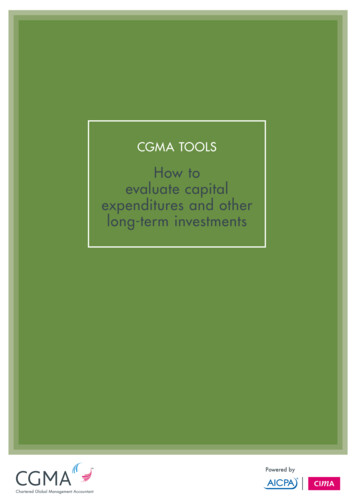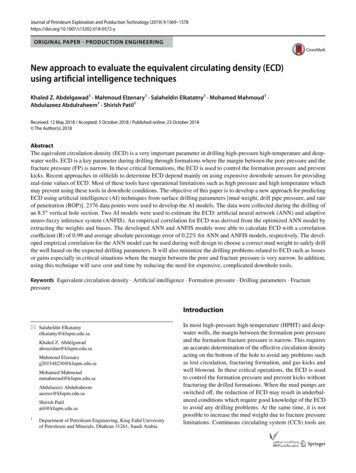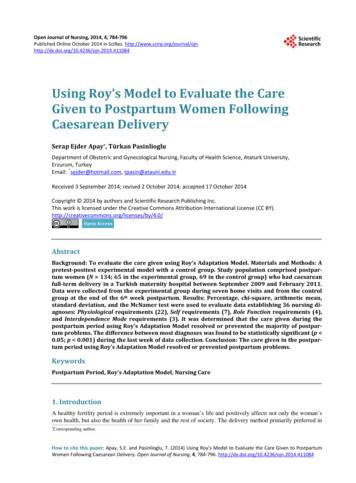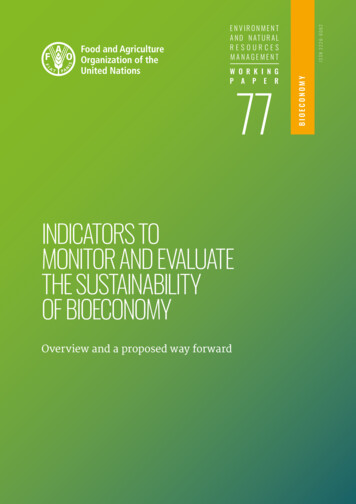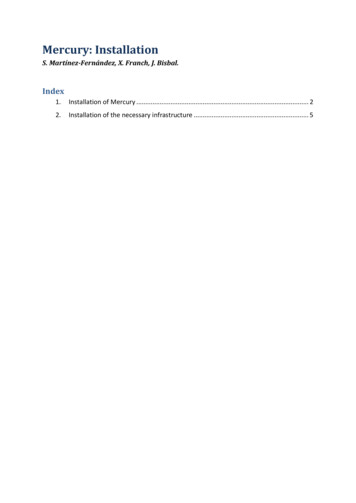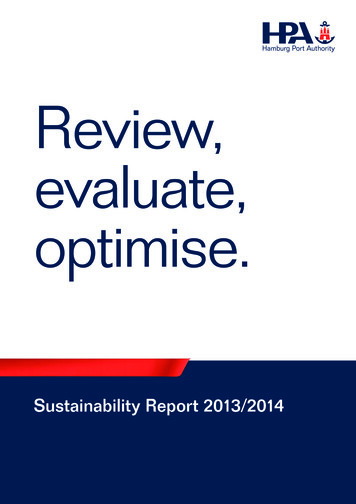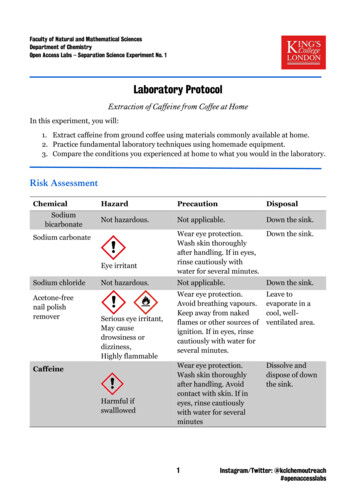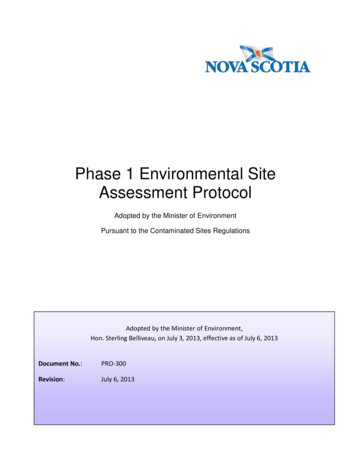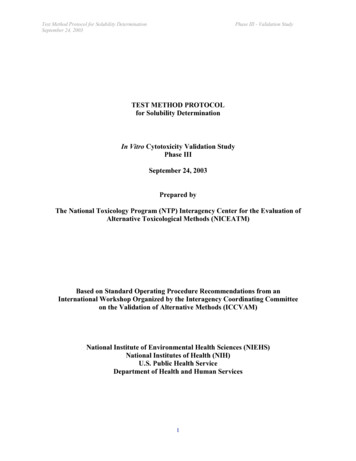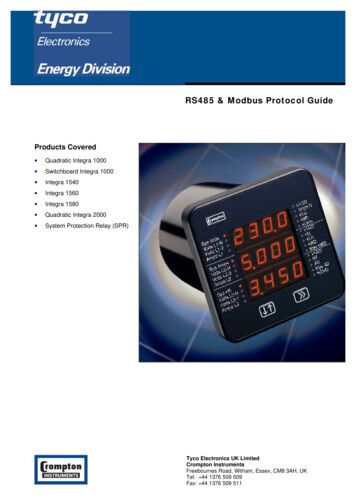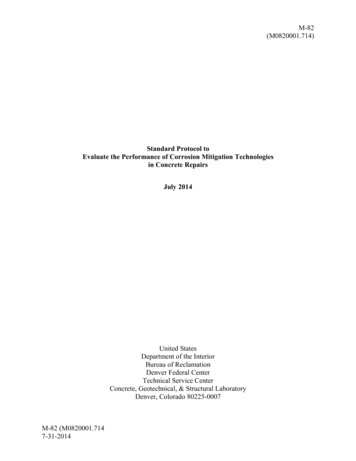
Transcription
M-82(M0820001.714)Standard Protocol toEvaluate the Performance of Corrosion Mitigation Technologiesin Concrete RepairsJuly 2014United StatesDepartment of the InteriorBureau of ReclamationDenver Federal CenterTechnical Service CenterConcrete, Geotechnical, & Structural LaboratoryDenver, Colorado 80225-0007M-82 (M0820001.7147-31-2014
IntroductionThe protocol for measuring the performance of corrosion mitigation technologies for concretereinforcing steel was first suggested by a group of industry recognized experts and strategic plannersin support of goals outlined in Vision 2020: “A Vision for the Concrete Repair, Protection andStrengthening Industry”. Vision 2020 is an industry created strategic plan and roadmap; documentswere developed over a several year period which began in 2003. Information about these documentsis available at the American Concrete Institute (ACI) Foundation’s Strategic Development Council(SDC) website.One goal of the Vision 2020 group was to develop a test protocol which could be used to evaluate theeffectiveness of steel reinforcement corrosion mitigation techniques for existing structures. As a firststep toward achieving that goal, a panel of industry experts met to discuss a proposed protocol duringthe summer of 2008. The panel reviewed and discussed currently available test methods, concreterepair industry needs, and current research programs. The panel stressed the importance of having aflexible test program that would properly evaluate the performance of current corrosion mitigationoptions while allowing for future innovations. The panel recommended a pilot program beconducted prior to final adoption of a testing protocol or initiation of any full scale testing program tovalidate the repeatability and reproducibility of the protocol.This protocol is the outcome of the pilot program which was conducted by the Bureau ofReclamation under a cooperative agreement with the SDC through contract awarded to TourneyConsulting Group (TCG). The contract was funded by Reclamation using funds from the ACIFoundation.Special thanks go to the panel of experts that devoted countless hours to developing, editing andrevising the protocol and to the review committee that reviewed the plans for the pilot program andsuggested changes to the protocol based on test results. None of this would have been possiblewithout their talent, hard work and expertise.Expert PanelPeter Emmons (Structural Group)Leandro Etcheverry (WP Moore)Yash Paul Virmani (FHWA)Alberto Saguez (University of South Florida)Matt Miltenberger* (Formerly TCG)Mukul Dehadrai (Formerly TCG)Bill Hartt (retired, Florida Atlantic Universityand Hartt & Assoc.)Daryl Little (Bureau of Reclamation)Jack Bennett (J.E. Bennett Consultants)Paul Noyce (Electrotech)Jacques Marchand* (University of Laval)Kelly Page (ICRI/Repair Council)Tony Nanni (U of Miami and ACI TAC)Fred Goodwin (BASF)*Principal authors of original draftReview CommitteePeter Emmons (Structural Group)Fred Goodwin, (BASF)Tanya Komas, (Univ. of Calif., Chico)Daryl Little, (BOR)Jaques Marchand (University of Laval)Dave McDonald (EIG)Brooks Bucher (TCG)Neal Berke (TCG)Kurt von Fay (BOR)M-82 - Standard Protocol to Evaluate the Performance of Corrosion Mitigation Technologies in Concrete Repairs2
M-82 - Standard Protocol to Evaluate the Performance of Corrosion MitigationTechnologies in Concrete RepairsPART 1GENERAL1.01SCOPEA.This test method covers two procedures for measuring and differentiating theperformance of reinforcing steel corrosion mitigating technologies for concrete repairscaused by damage due to chloride ingress.B.The values stated in inch‐pound units are to be regarded as standard. The SI values givenin parentheses are for information only.C.This standard does not address all of the safety concerns, if any, associated with its use.It is the responsibility of the user of this standard to establish appropriate safety andhealth practices and determine the applicability of regulatory limitations prior to use.1.02REFERENCE STANDARDSA.Unless otherwise indicated, use most recent version.B.American Concrete Institute (ACI)1.C.ACI 440.6Specification for Carbon and Glass FiberReinforced Polymer (FRP) Bar Materials forConcrete ReinforcementASTM International (ASTM)1.ASTM A 615/A 615 MDeformed and Plain Carbon-Steel Bars forConcrete Reinforcement2.ASTM A 706/A 706 MLow-Alloy Steel Deformed and Plain Barsfor Concrete Reinforcement3.ASTM A 1064/A 1064 MCarbon-Steel Wire and Welded WireReinforcement, Plain and Deformed, forConcrete4.ASTM C 31/C 31 MMaking and Curing Concrete TestSpecimens in the Field5.ASTM C 33/C 33 MConcrete Aggregates6.ASTM C 39/C 39 MCompressive Strength of CylindricalConcrete Specimens7.ASTM C 94/C 94 MReady-Mixed Concrete8.ASTM C 143/C 143 MSlump of Hydraulic-Cement Concrete9.ASTM C 150Portland Cement10.ASTM C 171Sheet Materials for Curing ConcreteM-82 - Standard Protocol to Evaluate the Performance of Corrosion Mitigation Technologies in Concrete Repairs3
D.11.ASTM C 231Air Content of Freshly Mixed Concrete bythe Pressure Method12.ASTM C 260Air-Entraining Admixtures for Concrete13.ASTM C 403/C 403 MStandard Test Method for Time of Setting ofConcrete Mixtures by PenetrationResistance14.ASTM C 494/C 494 MChemical Admixtures for Concrete15.ASTM C 881/C 881 MStandard Specification for Epoxy-ResinBase Bonding Systems for Concrete16.ASTM C 876Standard Test Method for CorrosionPotentials of Uncoated Reinforcing Steel inConcrete17.ASTM C 1017/C 1017 MChemical Admixtures for Use in ProducingFlowing Concrete18.ASTM C 1152/C 1152 M e1Acid‐Soluble Chloride ContentDetermination in Concrete19.ASTM C 1202Standard Test Method for ElectricalIndication of Concrete’s Ability to ResistChloride Ion Penetration20.ASTM C 1602/C 1602 MMixing Water Used in the Production ofHydraulic Cement Concrete21.ASTM C 1760Standard Test Method for Bulk ElectricalConductivity of Hardened Concrete22.ASTM D 632Standard Specification for Sodium Chloride23.ASTM F 2170Standard Test Method for DeterminingRelative Humidity in Concrete Floor SlabsUsing in situ Probes24.ASTM G 57-06Standard Test Method for FieldMeasurement of Soil Resistivity Using theWenner Four-Electrode Method25.ASTM G 187Standard Test Method for Measurement ofSoil Resistivity Using the Two-ElectrodeSoil Box Method1National Association of Corrosion Engineers (NACE)1.E.NACE/ASTM G 193-12dStandard Terminology and AcronymsRelating to CorrosionNational Electrical Manufacturer’s Association (NEMA)1.NEMA 250Enclosures for Electrical Equipment (1000Volts Maximum)M-82 - Standard Protocol to Evaluate the Performance of Corrosion Mitigation Technologies in Concrete Repairs4
F.The Society for Protective Coatings (SSPC)1.SSPC-SP 3Power Tool Cleaning2.SSPC-SP 8Pickling1.03SUMMARYA.The protocol involves the production of 40‐inch long by 40‐inch wide x 5.5‐inch thick(all dimensions /- 0.5 inch) concrete slabs with discrete steel reinforcing bars near thetop of the slab and welded-wire reinforcing (WWR) near the bottom of the slab.B.The steel bars are connected to the WWR through 1 ohm (Ω) resistors through switchesin a junction box attached to the side of the slab.C.The concrete slabs are cyclically ponded with a 5% by mass sodium chloride (NaCl)solution for two weeks and then the solution is removed for two weeks.D.The macrocell current between each bar and the WWR is determined by measuring thevoltage drop across the resistor. The positive macrocell currents (reinforcing steel bar iscorroding) are integrated over time to have total macrocell corrosion for each bar. Thetotal for all of the bars is also determined.E.The switches in the junction box are set so that all the bars and the WWR can beelectrically connected through the resistors. For potential mapping the bars areconnected.F.There are two configurations for the slabs:1.Configuration A slabs are used when the repair treatment is to be surface appliedonly (topical treatment).a.2.Topical treatment slabs have 6 steel reinforcing bars in the top layer thatare equally spaced apart, but are offset from one side to provide a sectionof the slab in which cores and resistivity measurements can be performedwithout affecting concrete near the bars.Configuration B slabs are used when concrete around corroding steel is removedas part of the repair method (topical or integral treatment). The slabs can also bemade with a defect that can be removed after a specified corrosion level isreached.a.Configuration B slabs for integral repair have a section called a hotspotthat can be removed during the repair process.b.Two steel reinforcing bars are located inside the hotspot. These bars arehalf-length bars supported by fiberglass bars to maintain their position.3.Repair technologies are applied according to manufacturer’s instructions once aspecified level of corrosion is reached.4.Measurements include:a.Half-cell potentialb.Macrocell corrosion currentsM-82 - Standard Protocol to Evaluate the Performance of Corrosion Mitigation Technologies in Concrete Repairs5
c.d.Concrete resistivity - Determined by the Wenner Four-Electrode method.Mat to mat resistance - Determined by disconnecting the WWR from thesteel reinforcing bars, but leaving the bars electrically connected.1.04SIGNIFICANCE AND USEA.This protocol provides a reliable means for:1.051.Predicting the mitigation of preexisting corrosion activity by a surface applied orintegral repair treatment.2.Comparing different mitigation technologies compared to control specimensreceiving no treatment.3.Development of studies of concrete repair systems for corrosion mitigation.4.This test method can be used to determine the corrosion threshold value forchloride induced corrosion for black steel under the specified test conditions.DEFINITIONS1.PART 2Corrosion initiation is defined as when the first bar has a potential more negativethan ‐300 millivolt (mV) vs. copper/copper sulfate (Cu/CuSO4) referenceelectrode (CSE) and the macrocell current is greater than 0.03 milliamp (mA), orthe macrocell current is greater than 0.03 mA for two cycles.PRODUCTS2.01ACCESSORIESA.Portable voltmeter (Minimum input impedance of 10 megohms and capable of measuringDC voltages between plus or minus 0.01 millivolt to plus or minus 100 volts).B.Meter for measuring Wenner four‐electrode resistivity and electrodes, as described inASTM G 57.1.Electrodes to be type 304 stainless steel, 1/8-inch diameter by 4-inches long.C.Portable Cu/CuSO4 reference electrode, as described in ASTM C 876.D.Equipment for measuring relative humidity (RH) and temperature in slabs according toASTM F 2170.E.Electroplaters tape.F.Polyolefin shrink tubing - 3M FP-301 Flexible Polyolefin meeting UL, CSA and MILDTL-23053/5 or equal.G.Liquid Electrical Tape.H.Epoxy - Meeting the requirements of ASTM C 881, Type IV, Grade 3 Class E withviscosity suitable for injection into tubing.M-82 - Standard Protocol to Evaluate the Performance of Corrosion Mitigation Technologies in Concrete Repairs6
I.Epoxy sealer - Meeting the requirements of ASTM C 881, Type III, Grade 1 Class C forsealing concrete slab sides.J.Extruded polystyrene or polyurethane closed cell insulation – For ponding dams, 2-inchesthick.K.Neoprene Tubing, with 3‐mm wall thickness and 0.5-inch inner diameter.L.Neutral cure silicone adhesive for bonding rigid foam insulation to concrete slabs.M.Type 304 Stainless steel screws, ¼‐inch diameter x 1.5 inch long – 20 thread, one per bar.N.Type 304 Stainless Steel Nuts, two per bar to fit stainless steel screws.O.Non-conductive supports for reinforcing.P.Wood pallets with minimum 30% openings between top slats for supporting and movingslabs.Q.Copper wiring, 16-gauge multi-strand, insulated.R.One Ω, 1% tolerance, 1 watt shunt resisters.1.Use 7 for Configuration A slabs.2.Use 10 for Configuration B slabsS.NEMA 250, Type 4X Junction Box.T.Switches to open and close circuits, compatible with wiring and resistors.1.U.One switch is needed per resistor.Single-wire (one conductor) banana plugs, female, to access the junction box, for outletconnections to the voltage meter.1.One banana plug is needed for each resistor.V.PVC pipe and fittings, or similar, for draining slabs.W.Sulfuric Acid, 10% by mass.X.Salt solution, prepared by dissolving 5 parts sodium chloride, complying with ASTM D632, in 95 parts potable water, by massY.Tools for finishing concrete – float, darby, broom finish, hand held bristle brush.2.02REINFORCINGA.Reinforcing Bars:1.ASTM A 615, Grade 60.2.Deformed steel bar.M-82 - Standard Protocol to Evaluate the Performance of Corrosion Mitigation Technologies in Concrete Repairs7
3.B.Size number 4, all from the same lot.Reinforcing Fabric: ASTM A 1064, electrically-welded wire fabric.1.C.W4/W4 6 x 6‐inchNon‐conductive Glass Fiber Reinforced Polymer - ACI 440.6‐081.Size number 3 to 52.03CEMENTITIOUS MATERIALSA.Portland cement:1.ASTM C 150, Type II.2.Meet equivalent alkali’s requirements of ASTM C 150 - Table 2.3.Meet false-set requirements of ASTM C 150 - Table 4.2.04WATERA.ASTM C 1602, including optional requirements of Table 2.2.05AGGREGATE MATERIALSA.Fine aggregate: ASTM C 33, including requirements of Table 2, and paragraph 7.3.B.Coarse aggregate: ASTM C 33, Size No. 7.2.06ADMIXTURESA.Air-entraining admixture:1.B.ASTM C 260.Chemical admixtures:1.2.Allowable chemical admixtures:a.ASTM C 494, Type A, D, F, G, or S.b.ASTM C 1017, Type I or II.Do not use chemical admixtures which contain more than 0.1 percent chloride, byweight.2.07CURING MATERIALSA.Water: ASTM C 1602, including optional requirements of Table 2.B.Polyethylene film: ASTM C 171, clear.1.Free from cuts or tears.M-82 - Standard Protocol to Evaluate the Performance of Corrosion Mitigation Technologies in Concrete Repairs8
2.08CONCRETE MIXTUREA.Cement: 517 to 611 lbs/cubic yardB.Net water-cementitious materials ratio: 0.48 to 0.52, by weight.C.Slump: 3 to 5 inches, in accordance with ASTM C 143.D.Air entrainment: 4 to 6 percent air by volume of concrete
ASTM C 94/C 94 M Ready-Mixed Concrete 8. ASTM C 143/C 143 M Slump of Hydraulic-Cement Concrete 9. ASTM C 150 Portland Cement 10. ASTM C 171 Sheet Materials for Curing Concrete . M-82 - Standard Protocol to Evaluate the Performance of Corrosion Mitigation Technologies in Concrete Repairs 4 11. ASTM C 231 Air Content of Freshly Mixed Concrete by the Pressure Method 12. ASTM C
